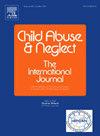Childhood maltreatment and its associations with multidomain health outcomes and brain structure: A comprehensive analysis of over 150,000 UK Biobank participants
IF 3.4
2区 心理学
Q1 FAMILY STUDIES
引用次数: 0
Abstract
Background
Childhood maltreatment, a pervasive public health concern, is linked to lifelong impairments in physical and mental health. Despite its profound implications, research on its associations with multidomain health outcomes and neurobiological mechanisms remains fragmented. We aimed to comprehensively assess the impact of childhood maltreatment on diverse health measures and brain structure using large-scale, multidimensional data.
Methods
In this population-based study, we analyzed data from the UK Biobank to examine the patterns and directions of associations between the severity of childhood maltreatment and 254 health-related measures across multiple domains, using linear mixed-effect models and adjusting for numerous confounders. Participants were included in the study if they had complete data on childhood maltreatment assessments, all covariates, and at least one health measure. The study also investigated the link between childhood maltreatment and brain structure, as well as the mediating role of this link in the association between childhood maltreatment and mental health outcomes.
Results
Childhood maltreatment severity was significantly associated with decreased cognitive performance (Cohen's d = 0.016–0.226), increased unhealthy lifestyle (d = 0.020–0.472), poor physical fitness (d = 0.004–0.400), increased symptoms of poor mental health (d = 0.051–1.197), and adverse biochemical markers (d = 0.014–0.062). Maltreatment severity was correlated with reduced gray matter volume (GMV) in the thalamus, postcentral gyrus, and cerebellum (d = 0.031–0.038). Longitudinal analyses indicated that thalamic GMV reductions mediated associations between maltreatment severity and 22 out of 55 mental health outcomes.
Conclusions
Childhood maltreatment exerts enduring multi-domain health effects, with mental health outcomes demonstrating the highest vulnerability. Structural thalamic alterations partially mediate these relationships, highlighting neurodevelopmental pathways through which early adversity becomes biologically embedded. This work provides a framework for understanding the systemic health impacts of childhood trauma and informing trauma-informed clinical strategies.
儿童虐待及其与多领域健康结果和大脑结构的关联:对超过150,000名英国生物银行参与者的综合分析
儿童虐待是一个普遍存在的公共卫生问题,与身心健康的终身损害有关。尽管其影响深远,但其与多领域健康结果和神经生物学机制的关联研究仍然零散。我们的目的是利用大规模、多维数据全面评估儿童虐待对各种健康指标和大脑结构的影响。在这项基于人群的研究中,我们分析了来自英国生物银行(UK Biobank)的数据,使用线性混合效应模型并调整了许多混杂因素,检验了儿童虐待严重程度与多个领域254项健康相关措施之间的关联模式和方向。如果参与者有关于儿童虐待评估、所有协变量和至少一项健康指标的完整数据,他们就被纳入研究。该研究还调查了儿童虐待与大脑结构之间的联系,以及这种联系在儿童虐待与心理健康结果之间的关联中的中介作用。结果儿童虐待严重程度与认知能力下降(Cohen’s d = 0.016-0.226)、不健康生活方式增加(d = 0.020-0.472)、体质差(d = 0.004-0.400)、心理健康不良症状增加(d = 0.051-1.197)、不良生化指标增加(d = 0.014-0.062)显著相关。虐待严重程度与丘脑、中央后回和小脑灰质体积(GMV)减少相关(d = 0.031-0.038)。纵向分析表明,丘脑GMV减少介导了虐待严重程度与55种心理健康结果中的22种之间的关联。结论儿童虐待对健康的影响是持久的、多领域的,其中心理健康结果的脆弱性最高。丘脑结构改变部分调节了这些关系,突出了早期逆境成为生物学嵌入的神经发育途径。这项工作为理解儿童创伤的系统性健康影响和告知创伤知情的临床策略提供了一个框架。
本文章由计算机程序翻译,如有差异,请以英文原文为准。
求助全文
约1分钟内获得全文
求助全文
来源期刊

Child Abuse & Neglect
Multiple-
CiteScore
7.40
自引率
10.40%
发文量
397
期刊介绍:
Official Publication of the International Society for Prevention of Child Abuse and Neglect. Child Abuse & Neglect The International Journal, provides an international, multidisciplinary forum on all aspects of child abuse and neglect, with special emphasis on prevention and treatment; the scope extends further to all those aspects of life which either favor or hinder child development. While contributions will primarily be from the fields of psychology, psychiatry, social work, medicine, nursing, law enforcement, legislature, education, and anthropology, the Journal encourages the concerned lay individual and child-oriented advocate organizations to contribute.
 求助内容:
求助内容: 应助结果提醒方式:
应助结果提醒方式:


